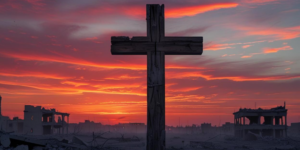Typhoon Babies Fight Against Odds in Ravaged Philippine City
In the chapel of the only functioning public hospital in typhoon-ravaged Tacloban, seven tiny, premature babies lie sweltering in intense heat, looked over by anxious mothers and a wooden statue of Christ.
An eighth, born two days after Friday’s monster storm hit the central Philippines, is kept alive only by his exhausted grandmother who pumps air by hand into his sick lungs. Only one baby, his face bruised purple from a hurried delivery by forceps, is strong enough to cry.
The others are eerily quiet as they battle to survive in a hospital without power, clean water, and running out of essential medical supplies.
It remains the only medical option in the city of Tacloban for most survivors of Typhoon Haiyan, which may have killed thousands of people. The storm destroyed all but two hospitals in the city, one of them private.
“Our immediate problems are immense,” said Dr. Alberto de Leon, the 62-year-old director of the hospital, the Eastern Visayas Regional Medical Center, adding he nearly lost his own life in the surge of ocean water that accompanied Haiyan.
Caught unaware by the wall of water that engulfed the city of 220,000 on Friday morning, he clung to a refrigerator as the living room of his single-story home filled almost to the ceiling.
At the entrance of the hospital, next to a sign asking people to take bodies straight to the morgue, urgent needs are listed on a makeshift sign: a generator, drinking water, oxygen, cooking gas, medicine and manpower.
A single gasoline-fueled generator is the only source of power, leaving patients to sweat in dark corridors as they await treatment from a wide range of wounds caused by the churning, debris-packed seawater.
That also means there is no way to stop the bodies of 18 victims of the typhoon from decomposing in the morgue.
“I’m worried the newborns will get hospital-acquired infections,” said de Leon. “The cadavers at the back could be a source.”
Many of the 80 babies born in the hospital since the typhoon came prematurely, their mothers shocked into labor by Friday’s trauma. In the chapel, a tangle of intravenous drips and oxygen has been planted between the pews to keep the newborns alive, but basic medicines are running short, nurses said.
The mostly Roman Catholic Philippines has one of Asia’s highest birth rates, particularly in poorer areas such as the central Visayas region.
Nanette Salutan, 40, went into premature labor hours after the storm blew the roof off her house in a small town near Tacloban.
She then endured a two-hour ride on the back of a motorbike, dodging fallen trees and electricity poles, before giving birth by flashlight in the hospital early on Saturday.
Heavily pregnant Mary Jane Tevez, 16, and her husband escaped from their own collapsing house on Friday only to be trapped in the rapidly crumbling home of a neighbor. She began feeling unbearable pain in her pelvis even as they fought for their lives by sheltering under thick plywood.
Their baby boy was born early on Saturday. Its name? Yolando, the masculine version of Typhoon Haiyan’s Philippine name Yolanda.
“It’s because we don’t want to forget what we had to go through and because we got another life,” said his father, Meller Balabog.
© 2013 Thomson Reuters. All rights reserved.







































